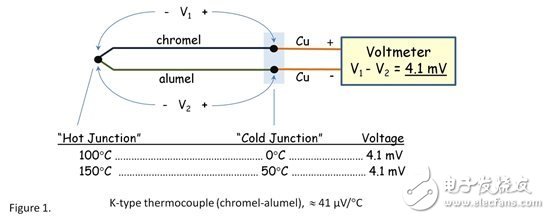Maybe you have never used a superheated coupler, assuming you don't have to know how it works, but I don't agree with it. I believe it is worthwhile to spend ten minutes reading relevant materials. If you are already familiar with how it works, please let me know when I am doing something wrong. A thermocouple is a temperature measurement sensor made of two different metals. They may be made of copper or iron, or they may be made of a special mixture of metals. Two wires of different metal materials are connected at one node (this gives us the first important point) - there is no voltage at the node, just like any two wires you want to connect, at the junction No voltage is generated. Now we know that when one end of the conductor is not the same temperature as the other end, a voltage is generated across the conductor. That's right, this is true! Regardless of the resistance of the wire, it only appears as a voltage and no current flows - this is the Seebeck effect. If we use two different metals, then two different voltages will be generated and the voltage difference between the two can be measured at the end of the open circuit, see Figure 1. Note that if you want to measure the absolute Seebeck voltage of a single wire of the same metal, then the wire you are measuring will produce the same voltage and the measured value is zero. You can only measure the difference between different pairs of wires. In completing this measurement, you will need to create one or more nodes on the measurement side (two nodes if both wires are not copper). We call this a cold junction because, in general (not often), the temperature at the end where the measurement is taken is higher than the temperature at the end where the measurement is not made. The thermocouple only measures the temperature difference. Note that in Figure 1, you measured the same voltage for both example cases. A temperature difference of 100 °C between the hot junction and the cold junction will produce a voltage of 4.1 mV. The old-fashioned way to get the absolute temperature measurement of the hot end is to immerse the cold junction in an icy water (this is another reason called a cold junction). The published thermocouple parameter table assumes a cold junction of 0 °C. If you want to know the absolute temperature of the hot junction but don't want to use the cold water immersion method, you must know the temperature of the cold junction. This measurement can be done using a semiconductor sensor such as TMP20 or ADS1118 (in conjunction with an A/D converter), thermostor, RTD, or other semiconductor sensor that can measure absolute temperature rather than relative temperature. Based on the measured cold junction temperature (see Figure 2), a voltage equal to the thermocouple coefficient is added. This work can be done in analog form or in digital form, called cold junction compensation. If the cold junction is 0 ° C, then the result of this total is the voltage that will be generated. If you need an absolute temperature sensor at the cold junction, why not just use the sensor to measure the hot end? Thermocouples can measure a wide range of temperatures: low temperature measurements up to 1800°C or higher, depending on the type. This may have other benefits depending on the application. If all wires produce the same voltage, why can't we see this effect repeatedly in our circuits? At normal temperatures for electronic applications, the voltage is very low and we typically use similar conductors that are the same or have a relatively low Seebeck coefficient. When we use different metals, the temperature of the two nodes will usually be the same. If you are measuring a small DC voltage, you need to be very careful. For example, when we measure the offset voltage of a high-precision chopper amplifier, we must choose our components and materials such as connectors and carefully route them. The mechanical layout must assume that the junction temperatures of the different conductors are close to other conductors and are thermally coupled. We use latched relays to minimize heat and keep other heat sources from becoming low-level circuits. Correct measurement of some micro-voltages is a complex task, and the accompanying thermocouples are usually the ultimate limit of accuracy. Circuit Board Pcba,Pcba Circuit Board Assembly,Electronics Pcb Pcba,Pcb Assembly Pcba Full Industrial CO.,ltd. , https://www.iotaindustrial.com
